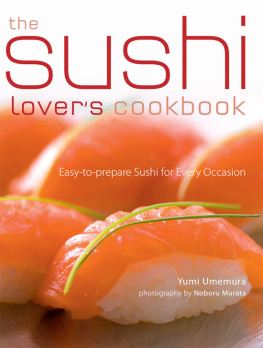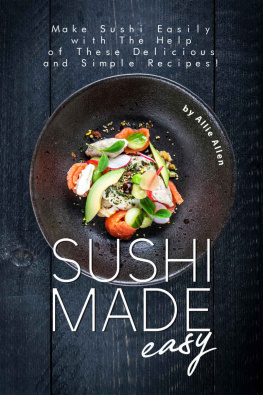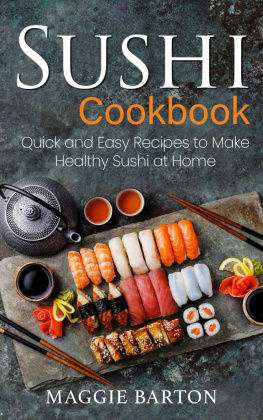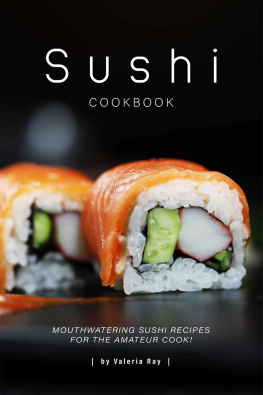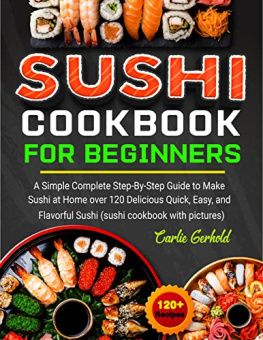Many people and organizations helped make this book a reality. I especially wish to thank:
Christina Oey, Eric Oey, Holly Jennings, Irene Ho (designer) of Tuttle Publishing
Misawa Homes Co., Ltd, Time & Style Co. Ltd Yoko Mizui
Tom Baker is a coauthor of the luxury travel guidebook Tokyo Chic and has also contributed to the Time Out guides to Tokyo. He has written about Japan for Jaguar , Continental , Japan Close-up and other magazines. He lives in Saitama Prefecture.
Masami Kaneko is a versatile stylist whose work has been described as both lively and creative. The scope of her work ranges from advertising to editorialincluding cookbooks, and interior design and food magazinesand includes consultation for wedding parties and restaurant table settings. She is based in Tokyo.
Sushi Basics
Sushi rice is special. As the literal foundation of most sushi recipes, the rice must stick together well enough to support the other ingredients. It needs to have a clean, appealing taste of its own without distracting from the other flavors that make sushi such a joy to eat. And it must be pleasing to look at, meaning that it is white and shiny and composed of clearly defined individual grains. The sushi rice recipes that follow will guide you through the process of making perfect sushi rice every time. Properly made sushi rice is not difficult to achieve; it simply takes care and attention.
Once youve made sushi rice, be sure to read Sushi Tips(pages 3639) before trying one of the recipes. If youre a beginner at making sushi, these tips will help you avoid typical sushi making pitfallssuch as rice thats become too dry to work with.
Yet the most important sushi-making tip I can give you is to urge you to be versatile and to have fun. At a basic level, this means that recipes in this book that call for brown rice can also be made with white rice, and vice-versa. And in many cases, unavailable ingredients may be eliminated, especially when you are making sushi rolls with several fillings. Dont be afraid to improvise substitutions for other ingredients when necessary. You may discover something wonderful.
Be inventive. Think of your favorite food combinations that are popular in your own culture to create your own sushi recipes. I hope that you use this book as a jumping-off point to explore your own creativity. Its the best tip of all!
BASIC SUSHI RICE
For practical and aesthetic reasons, including pleasing our taste buds, sushi rice should be firm, glossy, sticky and tangy. Some of the recipes in this book include innovative shortcuts for creating easy versions of sushi rice, using Simple White Rice as the base with handy ingredients such as lemon or lime juice to give the rice its requisite mildly sweet tang. But the traditional kind, using rice vinegar-based Sushi Dressing Sauce, can be used in all of the recipes in this book. Heres how to make sushi rice the old-fashioned way on the stovetop.
1 cup (200 g) uncooked Japanese or California short-grain rice
1 cup (250 ml) water
1 teaspoon sake (optional)
1 piece of kombu dried kelp, a few inches square (optional)

Rinsed short-grain rice ready to be drained Rice cooked with kombu Cooked rice ready for mixing Adding sushi dressing to cooked rice Mixing rice with sushi dressing in the handai
SUSHI DRESSING SAUCE
5 teaspoons rice vinegar
2 teaspoons sugar 1
teaspoons salt
Thoroughly rinse the rice in several changes of water until it runs crystal clear. Soak the rice in water for at least 30 minutes and drain thoroughly before cooking.
Bring the water to a boil in a saucepan, adding the sake if desired. Drain the rice and add it to the boiling water. Stir once, and return to a boil. Add the kombu, if using. Reduce the heat to the lowest setting, cook for 10 minutes, then turn off the heat and allow it to stand for 510 minutes more, covered, to finish cooking. ( Note : Although this stovetop method is my preferred way to prepare sushi rice, you may also use an automatic rice cooker. If youre using a rice cooker, use the same amounts described above and follow the manufacturers instructions.)
To make the Sushi Dressing Sauce, combine the vinegar, sugar and salt in a cup, and mix well until the sugar and salt are fully dissolved. The sauce should become clear. Remove the kombu and turn the rice into a large wooden mixing bowl or handai. If you have no wooden containers, a non-reactive casserole dish or deep platter will suffice.
Avoid digging or scooping the rice out of the saucepan, as this will damage some of the grains. It helps, however, to run a rice paddle or spatula around the edges of the cooked rice to loosen it before turning it out of the saucepan. Once it is in the bowl, gently break up the mass of rice with a few smooth, straight, slicing motions of your spatula. Pour the Sushi Dressing Sauce slowly over the back of your rice paddle or spatula, moving it to and fro over the rice so that the sauce is evenly sprinkled all over the rice.
Mix the rice to distribute the sauce thoroughly. To preserve the integrity of the grains and avoid mashing them together, do not use circular stirring motions but instead slice the rice at an angle with your paddle or spatula, lifting it and turning it over in sections or chunks.
When the sauce is well distributed, begin to fan the rice while continuing to mix it. (You can do this yourself, but its much easier to have a helper do the fanning while you do the mixing.) Fanning will cool the rice to a usable temperature and also helps evaporate the excess moisture. The sugar will give the grains an appealing gloss, which is an essential characteristic of good sushi rice.
Moisten and wring out a fine cotton cloth such as a thin dish towel or cloth napkin and place it on top of the rice to keep it from drying out. The cloth should rest lightly on the surface of the rice. Keep it covered until you are ready to make sushi with it. Rice covered in this way should remain good for several hours, or until the cloth dries out. Remoisten the cloth if it dries out.
Sushi rice will loose some flavor if kept out for more than a few hours. Leftover sushi rice can be refrigerated or frozen and later warmed up with steam or in a microwave, but it will lose some flavor and stickiness in the process.
For best results, eat it all on the day you make it.
Note: This recipe may be doubled or even tripled, but it should not be reduced.
Time 1 hour Makes 1 standard quantity (about 2 cups/400 g)
BROWN SUSHI RICE
Although white rice is a staple in Japan, brown ricecalled genmaiis enjoyed as well. Some of the recipes in this book take advantage of genmais darker color and extra flavor by using it instead of white rice as the basis of sushi. Brown rice tends to be harder and less sticky than the white variety, but this method gives you rice that is easy to work with and that has a classic sushi mouthfeel.
To make Brown Sushi Rice, use a brown variety of Japanese or California short-grain rice and follow the same recipe as for Basic Sushi Ricebut with some key differences. Soak the rice for at least 1 hour instead of 30 minutes and instead of cooking the rice in an ordinary pot or rice cooker, use a pressure cooker, following the instructions that came with your particular model.

